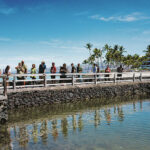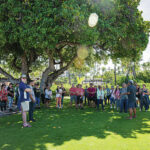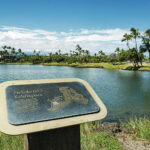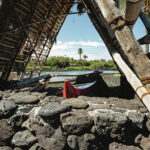Native Hawaiian council seeks to develop Big Island economic opportunities




WAIKOLOA — The Council for Native Hawaiian Advancement already has gotten a firm foothold in tourism products, especially in Waikiki, since securing a multiyear, $27 million contract for stewardship services in 2023 from the Hawai‘i Tourism Authority.
CNHA CEO Kuhio Lewis told the Honolulu Star-Advertiser that he now has set his sights on bringing services and economic development to Hawaii island — a decision that was reflected in CNHA’s choice of the island for its 2024 Native Hawaiian Convention, “Experience Hawai‘i Island,” which ran from Tuesday through Thursday.
“If you want to change the trajectory for the future, I think Hawaii island can actually create solutions that are not as easy to implement on Oahu and Maui,” he said. “The land prices are stable and the politics aren’t as bad. There are lots of economic growth opportunities, and we are focusing in on Hilo.”
Evidently, others see Lewis’ point. Some 2,087 attendees came to the conference at Hilton Waikoloa Village Resort, which sold out all of its hotel rooms early along with other nearby hotels.
CNHA’s recent acquisition of some 43 acres of land in Hilo for an undisclosed price generated plenty of conference buzz. Lewis said CNHA could break ground as early as 2025 on its first ground-up affordable housing development, which could provide 88 affordable single-family homes in the Kaumana subdivision of Ponahawai.
“We’ll be creative with how we do it. It won’t be exclusive to Native Hawaiians, but it will target local families,” Lewis said. “We are looking at putting it in some kind of land trust so that the land doesn’t get sold off and instead remains in local people’s hands.”
Polarizing topic
Tourism, once seen as a polarizing topic for Native Hawaiians, was heartily discussed by conventioneers. Native Hawaiian and Pacific Islander leaders, who now hold the top state tourism leadership roles, participated in a panel to mark the moment and to share their strategies to improve resident sentiment, especially from the lahui, toward tourism.
Aaron Sala, newly named president and CEO of the Hawai‘i Visitors and Convention Bureau, said: “I don’t want to be an icon. I just want to do the work.
“The challenge with the narrative becomes really dangerous for us as Hawaiians trying to do this kind of work in this kind of industry at this particular time because the expectation gets so high and mighty — we will disappoint you over and over and over again.”
Lewis later told the Star-Advertiser that he doesn’t think disappointment is a foregone conclusion when community decisions are at the heart of expanding regenerative tourism models. For instance, he said CNHA wants to explore opportunities to reinvigorate Banyan Drive, where the state owns and directly manages properties with ground-lease expirations, including hotels.
The state Department of Land and Natural Resources said the Uncle Billy’s property currently has no lease or revocable permit on it and is “empty” apart from the contractor on-site conducting the demolition, and there may be opportunities for renovation or further development of select other Banyan Drive properties.
Lewis, who has made his career on bold moves, said he wants to create workforce development opportunities through a Native Hawaiian-managed hotel. He said that he views Banyan Drive as a more promising possibility than Waikiki, where CNHA has introduced new tourism products but so far has found the barriers to entry for hotel real estate too high.
“As a prime contractor for tourism, (we’d like) to work with the state to reimagine what that Banyan Drive district could look like — it’s very exciting, and it could couple well with our plans to move aggressively into developing housing on that island.”
Local influence
Lewis said opportunities for Hawaii island tourism also are enhanced by the presence of Merrie Monarch and of several major fashion designers, including Kaulua‘e Hawai‘i, MANAOLA and Sig Zane Designs, which were featured during the convention at a “Fashion, Food &Culture Showcase” presented by Alaska Airlines.
“I can already see our local designers influencing what the experience is when you go to one of those Banyan Drive hotels or when you go down Banyan Drive,” he said. “Curating this beautiful, authentic experience that our local designers have contributed to — that’s the kind of tourism model that excites me. In Waikiki that’s going to be hard, but over there you can create the future.”
Conventioneers also learned that CNHA’s new Hawaii island investments include the purchase of Hawai‘i Stage, formerly Hawai‘i Stage &Lighting Rentals, for an undisclosed price.
Lewis said this newest acquisition allows CNHA to continue supporting Native Hawaiian artists and cultural practitioners, and strengthen its presence in Hawaii’s visitor industry. Hawai‘i Stage, which has had facilities on Oahu and Hawaii island over its 48-year history, has been involved in more than 8,000 projects, including major events like the Sony Open, Bellator MMA, “American Idol” and concerts featuring Bruno Mars and Janet Jackson.
More recently, Hawai‘i Stage has been a part of CNHA’s push into Waikiki with its debut of the Kilohana Hula Show and its “Na Lei Aloha” dinner show. The Kilohana Hula Show, presented by Southwest Airlines, launched in February, and earlier this month temporarily moved to the Kuhio Beach Hula Mound to allow the city to complete renovations on the Waikiki Shell. The free hula show, which is held Monday, Tuesday and Wednesday mornings at 9:30, features Merrie Monarch Festival dancers and is produced by the former entertainment stage director from the renowned Old Lahaina Luau.
CNHA began “Na Lei Aloha,” an evening hula dinner show, on Aug. 4 at the Hyatt Regency Waikiki Beach Resort and Spa. The show uses music and hula to share Hawaii’s rich cultural history of lei, which represented reciprocity long before regenerative tourism and destination stewardship were industry goals. Prices for the shows, which are offered Sundays through Thursdays, start at $99 for show-only packages to $179 for dinner-show packages; however, discounts are available to locals and the military.
Lewis said CNHA has seeded the Waikiki tourism products, which are outside the scope of their HTA stewardship contract, with $300,000 a month in investment, including 70 hula dancers on the payroll.
Strategic focus
CNHA’s choices of convention locations have been strategic as it has expanded its focus over the past few years. CNHA went to Las Vegas in June 2023 for its Western Regional Native Hawaiian Convention — its first convention ever on the mainland. Lewis said the choice reflected population shifts identified in the 2020 U.S. census, which showed that 53% of Native Hawaiians now lived in other U.S. states and only 47% of Native Hawaiians lived in Hawaii.
Overall, 680,442 Native Hawaiians were counted in the United States in 2020, a 29% increase over 2010. But the Native Hawaiian population on the mainland grew five times faster than Hawaii’s Native Hawaiian population.
CNHA, which has a firm anchor on Oahu, drilled down to the county level in November when it held its annual Native Hawaiian Convention on Maui, which needed support after the devastating Aug. 8, 2023, Maui wildfires.
Christopher Kapono Ishizaka, a Maui-based senior event operations director for Hawaii Tours, attended the Hawaii island conference in part because Maui’s tourism decline after the fires has afforded the island the chance to reset.
Ishizaka said telling visitors not to come to Maui after the fires backfired.
“We can’t be angry at people for wanting to visit. We shouldn’t be,” he said. “If we tell people not to come, then the respectful ones don’t come and the nonrespectful ones come.”
Maui’s fire-related challenges inspired Ishizaka to sign up for an immersive bus tour put together by CNHA’s Kilohana to demonstrate what regenerative tourism looks like through a Kanaka Maoli lens, which prioritizes place-based, community-controlled experiences.
“Just like the tiered farming system of the ahupuaa, water can drown the crops, but channeled right, it can feed the crops,” Ishizaka said. “Tourism is that same thing. It shouldn’t slowly erode the island; it should build it up.”
Malia Sanders, executive director of the Native Hawaiian Hospitality Association, estimated about 100 conventioneers went on the immersive journey, which visited Kalahuipua‘a Historical Park, Pu‘ukohola Heiau National Historic Site and Mahukona.
She said the stops highlighted the role that local community experts, musicians, hula dancers, artisans and local businesses can play in engaging visitors to take care of this place, as well as the places where they come from.
“It’s not just about what happens in Hawaii. It’s about changing their hearts and minds so that wherever they visit and wherever they go that (they) are practicing regeneration in everything that (they) do,” Sanders said. “The principles apply to climate change. They apply to everything — to health and wellness and all kinds of industries. It’s not just tourism.”








